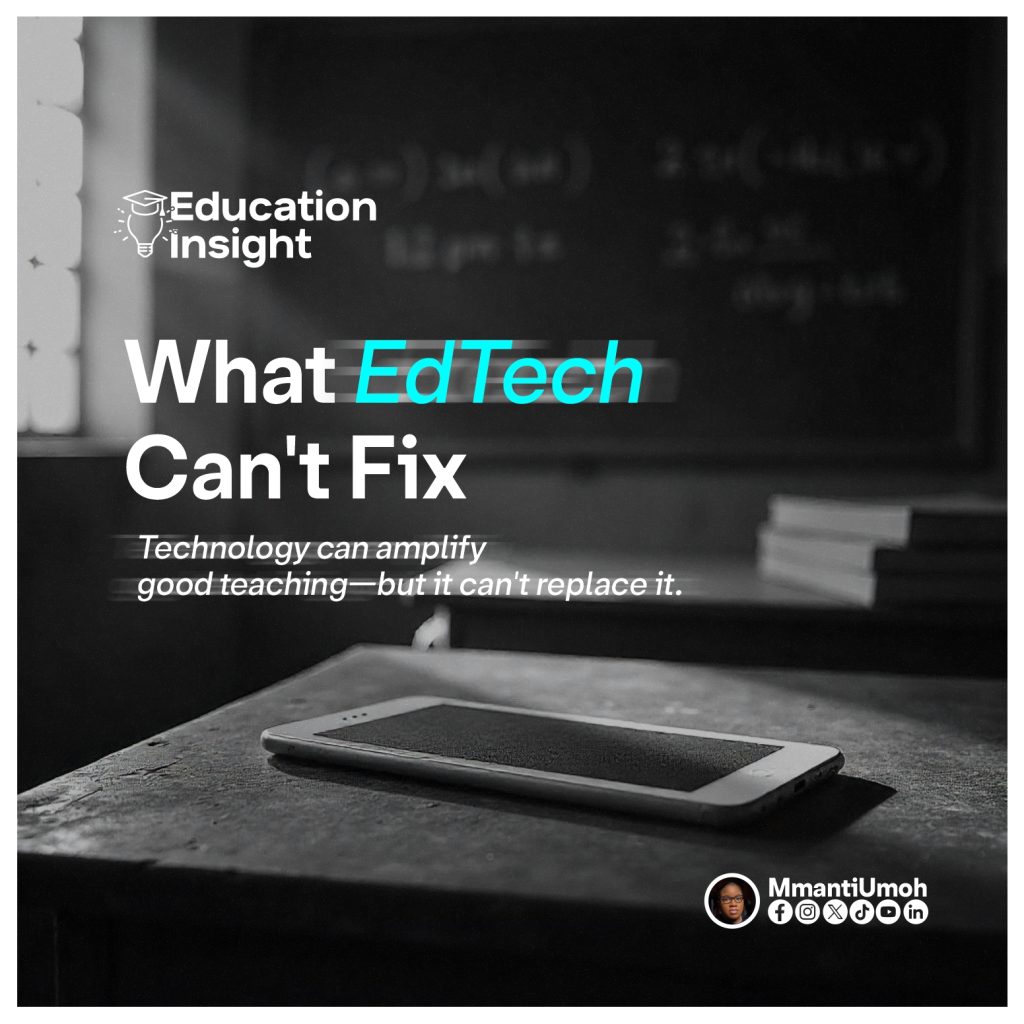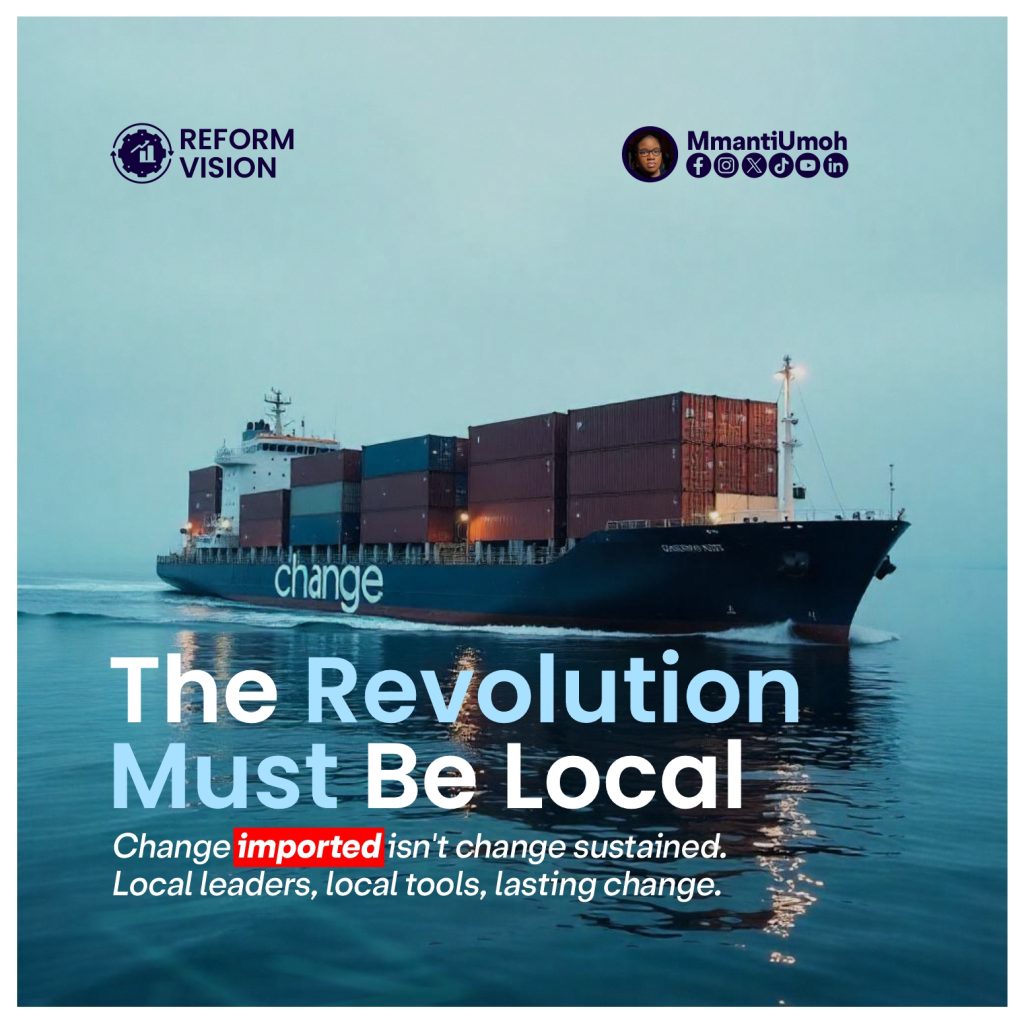By Mmanti Umoh

“We can digitize delivery, but we cannot automate understanding. True education is not only about access to knowledge—it is about connection to meaning.”
Across Africa and the broader Global South, EdTech has rapidly become a central pillar of education reform. It is lauded for its potential to bridge inequality, expand access, and accelerate learning outcomes. Policymakers promote it as a solution to everything from teacher shortages to curriculum limitations. Investors see it as a market with untapped potential. Educators, at times overwhelmed, see it as a much-needed support system.
And yet, EdTech has its limits.
It is not a cure-all. It is a tool. A powerful one, yes—but one that must be deployed with precision, nuance, and above all, humility.
Because the most critical aspects of learning—identity, belonging, emotional resilience, trust—cannot be automated. They cannot be scaled through code. They cannot be replicated by AI.
As we rush to modernize education, we must pause to ask:
What is education actually for?
And what does it mean to learn in a way that shapes not just performance, but personhood?
🔍 1. Efficiency Does Not Equal Empathy
EdTech is brilliant at delivering knowledge efficiently. It can break down lessons into digestible modules, personalize learning paths through data, and offer real-time feedback in ways that traditional classrooms often cannot.
But what it cannot do is sense nuance.
A child who stares blankly at the screen may not be disengaged—they may be hungry.
A student who refuses to log in may not be disobedient—they may be battling a household where learning is the least of their concerns.
A perfectly completed exercise may hide the fact that the student memorized the pattern, not the principle.
EdTech is blind to the layers beneath performance.
The teacher—present, perceptive, and emotionally intelligent—can detect when learning is being compromised by life. Human beings read tone, posture, pauses. They adjust pace not just based on scores, but on signs. This is not softness—it is intelligence of another kind. The kind that recognizes education as a human process.
2. Adaptation Is Not the Same as Engagement
One of the major promises of EdTech is personalized learning—content that adjusts to a student’s progress, strengths, and weaknesses. This is a tremendous asset in large, under-resourced classrooms where teachers are overburdened and time is limited.
However, adaptation is not engagement.
A system that increases or decreases difficulty based on correct answers is responding to data, not to people. It cannot detect boredom, curiosity, fear, or inspiration. It cannot tell when a student has disengaged emotionally, even if their answers are technically correct.
Engagement requires a social contract. It is fueled by trust, affirmation, and relevance. When a student sees that their effort is noticed by someone who cares, their cognitive investment deepens. They try harder not just for the grade—but for themselves, and sometimes, for the person who believes in them.
Technology can support this process. But it cannot be it.
3. Culture Cannot Be Coded
EdTech platforms, particularly those imported or designed from global hubs, often carry embedded assumptions about the learner. They assume access to stable internet, a certain linguistic fluency, a cultural familiarity with individualistic learning styles, and even certain visual norms.
But education is not neutral. It is deeply cultural.
A curriculum that ignores oral tradition in a society built on storytelling misses the pedagogical strengths of that culture. An app that gamifies learning based on competitive reward structures may not resonate in a collectivist community that values collaboration. A platform that excludes local languages reinforces exclusion.
When we implement EdTech without embedding it in the lived realities of learners, we create systems that may function—but do not connect.
The risk is clear: we digitize education but dehumanize it in the process.
4. The Teacher Is Not Replaceable—They Are Foundational
There is a growing narrative that technology can fill the teacher gap, especially in rural or underserved areas. While it’s true that EdTech can supplement and support where teachers are scarce, it is dangerous to position it as a replacement.
The teacher is not merely a transmitter of facts. They are a facilitator of curiosity. A guardian of confidence. A witness to growth.
In many African classrooms, the teacher is one of the few stable adult presences in a child’s life. They offer consistency in chaos. They model professionalism. They humanize knowledge. They are translators of complexity.
Even the most advanced AI cannot replicate the nuanced, evolving judgment of a skilled teacher. Nor can it replace the social role that educators play in shaping communities and modeling civic behavior.
EdTech may be the delivery system.
But the teacher is still the curriculum.
5. Innovation Must Serve, Not Distract
Innovation in education is essential. But it must serve a higher goal. When EdTech becomes an end in itself—when we prioritize flashy tools over deep learning—we risk confusing novelty for progress.
Technology must serve pedagogy, not override it.
Every innovation should be interrogated:
- Does this enhance human connection or reduce it?
- Does it expand access to meaningful learning, or just expand metrics?
- Does it empower educators, or displace them?
We must build systems that are not only smart, but wise. Systems that are not only scalable, but sustainable.
Because progress that severs us from the core purpose of education—preparing humans for life, not just exams—is no progress at all.
🔁 6. What We Can—and Cannot—Outsource
We can outsource content delivery.
We can automate assessment.
We can digitize access.
But we cannot outsource care.
We cannot automate trust.
We cannot digitize dignity.
Education is not just about what the learner knows. It is about who the learner becomes.
And that journey, no matter how technologically enhanced, will always require human engagement, emotional context, and cultural fluency.
Final Reflection: Technology Amplifies. Humans Transform.
EdTech is not the enemy of education. It is a tool with immense promise—especially in resource-constrained contexts. But the danger is in misplacing our hope. Believing that software alone can solve deeply human problems is not innovation. It is abstraction.
Technology amplifies what is already present. If we build systems rooted in empathy, equity, and excellence, EdTech can scale those values. But if our systems are already disconnected and dehumanized, technology will only make them faster—not better.
The future of education will be shaped by devices. But it must still be delivered by people.

